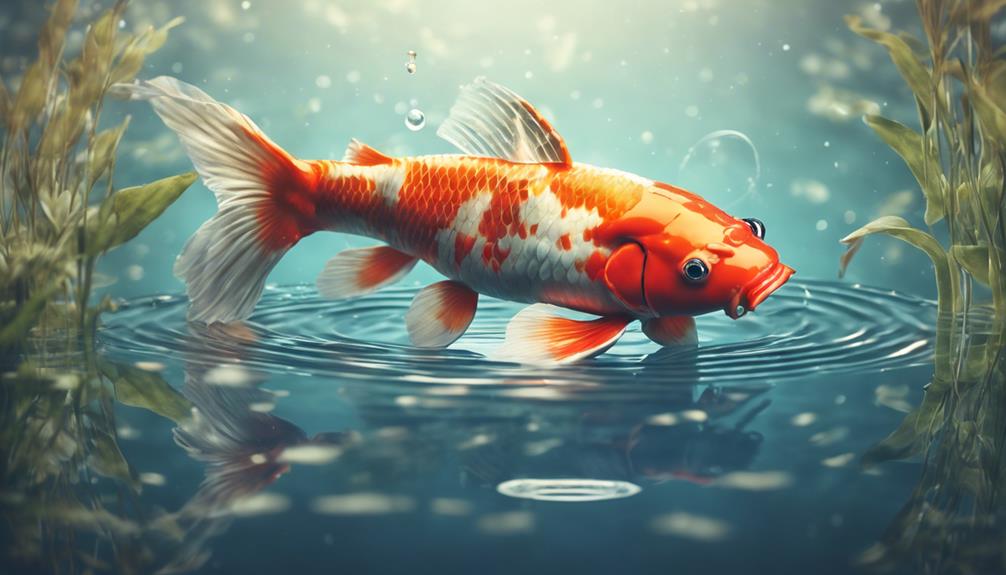You're about to set out on a koi fish breeding journey, and it's imperative to understand that genetics plays a pivotal role in determining the characteristics of your offspring. The genetic makeup of parent fish passes on specific traits, such as color, pattern, and scale type, to their offspring. Chromosomes carry this genetic information, and understanding how they interact is paramount for predicting breeding outcomes. Meiosis increases genetic diversity, and gametogenesis affects the quality of your fish. By grasping these fundamental concepts, you'll be well-equipped to make informed decisions in your breeding program. Now, dive deeper into the intricacies of koi fish genetics to reveal the secrets of successful breeding.
Table of Contents
Key Takeaways
- Genetics determines the characteristics of koi fish offspring, making it essential for predicting the outcome of breeding programs.
- Chromosomes carry genetic information, and understanding karyotype is vital for predicting the inheritance of traits in koi fish.
- Meiosis increases genetic diversity through shuffling and recombination of genetic material, affecting the characteristics and traits of koi fish.
- Gametogenesis plays a pivotal role in determining the success of breeding endeavors, directly affecting the quality and characteristics of koi fish.
- Understanding genetic variation, meiosis, and sex determination mechanisms is crucial for breeding koi fish with desirable traits and characteristics.
Genetics Basics for Koi Breeding
To understand koi fish breeding, you must first grasp the fundamental principles of genetics, as the genetic makeup of parent fish determines the characteristics of their offspring.
Fundamentally, genetics is the study of heredity, and it plays a vital role in koi fish breeding. You see, the genes of parent koi fish are responsible for passing on specific traits to their offspring, such as color, pattern, and scale type.
As a breeder, understanding how these genes interact and express themselves in the fish is imperative.
When it comes to koi fish breeding, genetics is key to predicting the outcome of breeding programs. By understanding the genetic principles, you can make informed decisions about which fish to breed together to achieve specific traits in their offspring.
For instance, if you want to produce koi with a particular scale pattern, you need to understand how the genes responsible for that pattern are inherited.
Understanding Chromosomes and Karyotype
You're now ready to explore the fundamental units of heredity, chromosomes, which carry the genetic information responsible for the traits you're trying to breed in your koi fish. Chromosomes are thread-like structures found in the nucleus of every cell, and they're made up of DNA and proteins. In koi fish, chromosomes exist in pairs, with 50 chromosomes in total (25 pairs).
| Characteristic | Male | Female |
|---|---|---|
| Chromosome number | 50 | 50 |
| Sex chromosomes | XY | XX |
| Autosomes | 48 | 48 |
The karyotype, or chromosome complement, of koi fish is typically represented as 50, XX or XY, indicating the total number of chromosomes and the sex chromosomes present. The XX combination is typically found in female koi, while the XY combination is typically found in male koi. Understanding chromosomes and karyotype is vital in koi fish breeding, as it helps you predict the inheritance of traits and make informed breeding decisions. By grasping these fundamental concepts, you'll be better equipped to create the vibrant, healthy koi fish you've always wanted.
Meiosis, Mendel's Laws, and Variation
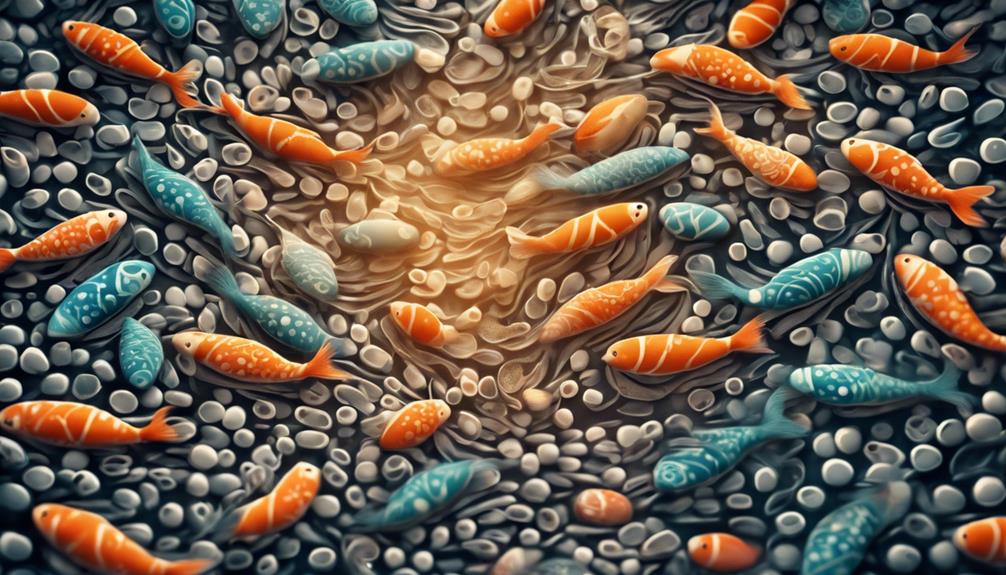
As you explore koi fish breeding, you'll discover that meiosis plays a vital role in generating genetic variation.
Meiosis, which involves the shuffling and recombination of genetic material, increases the genetic diversity of offspring.
Meiosis and Variation
Breeding koi fish requires an understanding of meiosis, the complex process by which your fish's gametes (sperm and eggs) develop, as it directly influences the genetic variation of their offspring. This process is vital in shaping the genetic makeup of your koi fish, ultimately affecting their characteristics and traits.
During meiosis, genetic information is shuffled and recombined, resulting in unique combinations of alleles. This leads to genetic variation, which is essential for the health and diversity of your koi fish population.
Genetic variation mechanisms:
Crossing over: The exchange of genetic material between homologous chromosomes, increasing genetic diversity.
Independent assortment: The random segregation of alleles during gamete formation, further increasing variation.
Random fertilization: The chance combination of sperm and egg cells, adding to the genetic mix.
Mutations: Spontaneous changes in DNA, introducing new genetic variations.
Genetic Recombination Process
Your understanding of meiosis sets the stage for exploring the genetic recombination process, where the principles of Mendel's laws and variation come into play.
As you dig into the genetic recombination process, you'll discover how it's the key to creating unique characteristics in your koi fish. This process involves the shuffling of genetic information, resulting in offspring with distinct traits.
Mendel's laws of inheritance, such as the law of segregation and the law of independent assortment, govern this process, ensuring that each offspring receives a unique combination of genes.
Variation is essential in this process, as it provides the genetic diversity necessary for selective breeding.
By understanding how genetic recombination works, you can make informed decisions when selecting breeding stock, increasing the chances of producing desired traits in your koi fish.
At its core, mastering the genetic recombination process is vital for successful selective breeding, allowing you to craft the perfect koi fish that meets your desired standards.
Independent Assortment Impact
During meiosis, the law of independent assortment guarantees that genes for different traits are sorted into gametes independently, allowing for an exponential increase in the number of possible genetic combinations in your koi fish offspring. This fundamental concept, first described by Gregor Mendel, is vital in understanding the genetic variation that arises in your koi breeding program.
Increased genetic diversity: With genes for different traits being sorted independently, you can expect a significant increase in genetic variation in your koi offspring.
Unpredictable trait combinations: Independent assortment leads to novel combinations of traits, making it challenging to predict the exact characteristics of your koi offspring.
Higher chances of desirable traits: With more genetic combinations possible, you have a higher chance of breeding koi with desirable traits, such as vibrant colors or unique patterns.
Improved breeding outcomes: By understanding independent assortment, you can design a more effective breeding strategy, increasing the likelihood of producing high-quality koi fish.
Gametogenesis, Development, and Sex
As you explore into the intricacies of koi fish reproduction, it becomes clear that gametogenesis, the process of generating gametes, plays a pivotal role in determining the success of your breeding endeavors.
This process involves spermatogenesis, the production of sperm cells, and oogenesis, the production of egg cells. Understanding these processes is essential for breeding koi, as it directly affects the quality and characteristics of your fish.
In oogenesis, each secondary oocyte normally produces only one haploid egg, while the rest become non-functional polar bodies. Once fertilization occurs, the resulting diploid zygote undergoes mitosis, leading to the growth and development of the fish.
As a breeder, grasping the intricacies of gametogenesis is fundamental for producing high-quality koi with desirable traits. By understanding how gametes are generated, you'll be better equipped to make informed decisions about your breeding program, ultimately leading to more successful outcomes.
Sex-Determination Systems in Fish
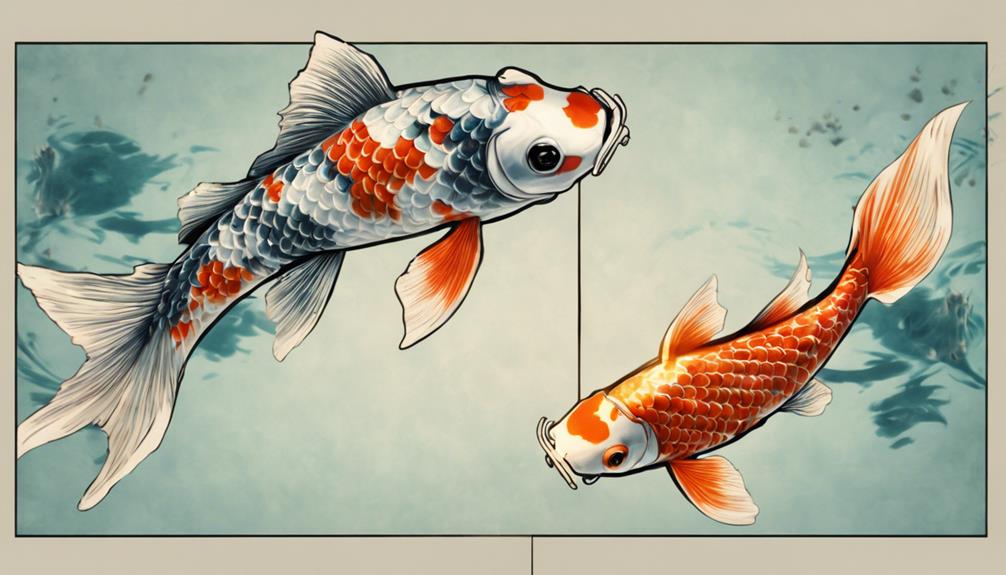
As you explore the complexities of koi fish breeding, you'll encounter various sex-determination systems that govern the development of your fish.
You'll discover that the XY diploid system, where females have identical sex chromosomes and males have a mix, is just one of several systems that exist in fish.
Now, let's examine the WZ and ZO systems, as well as autosomal sex determination, to gain a deeper understanding of how these mechanisms influence the sex of your koi offspring.
XY Diploid System
As a koi fish breeder, understanding the XY diploid system is vital in predicting and controlling the sex of your offspring.
In the vast majority of fish species, including koi, the XY diploid system dictates the sex of offspring, where the presence or absence of a Y chromosome determines whether an individual will develop as male or female.
Females have identical sex chromosomes (XX), while males have a mix (XY).
The father contributes either an X or Y chromosome, while the mother contributes an X chromosome to the offspring.
The combination of sex chromosomes determines the sex of the offspring, with XX resulting in a female and XY resulting in a male.
This system is inherited from the parents, ensuring a balanced and healthy population.
WZ and ZO Systems
You'll encounter alternative sex-determination systems in certain fish species, including the WZ and ZO systems, which diverge from the familiar XY diploid system.
These systems are essential to understand when it comes to breeding koi fish.
In the ZZ/ZO system, found in species like sunfish, males are determined by the ZZ genotype, resulting from the fertilization of a Z-carrying egg by a Z-carrying sperm.
Females, on the other hand, have a ZO genotype, produced by the fertilization of an egg with no sex chromosome by a Z-carrying sperm.
In contrast, the WZ system, found in platyfish, operates oppositely to the XX/XY system, where males are ZZ and females are WZ.
Understanding these sex-determination systems is pivotal for successful breeding, as it allows you to predict and control the sex of your offspring.
Autosomal Sex Determination
As you explore further into the world of breeding koi, understanding autosomal sex determination is vital.
In addition to the WZ and ZO systems, another sex-determination mechanism found in fish is autosomal sex determination, which doesn't rely on sex chromosomes to define the gender of an individual.
This mechanism is more complex, involving multiple genes on multiple chromosomes.
Autosomal sex determination involves multiple genes working together to determine the sex of an individual.
Unlike WZ and ZO systems, autosomal sex determination doesn't rely on sex chromosomes to define gender.
Environmental factors, such as temperature, can influence the sex of an individual in autosomal sex determination.
Autosomal sex determination allows for more genetic variation, which can be beneficial for breeding koi.
Koi Origins and Early Breeding History
Over 2,000 years ago, the Common Carp (Cyprinus Carpio) was transported from Eurasia to the Far East, ultimately giving rise to the diverse array of Koi breeds we're familiar with today.
You're probably wondering how this humble fish evolved into the stunning, vibrant creatures you see in koi ponds today. It all started when Japanese farmers kept the Common Carp in mud ponds as a food source.
Over time, natural mutations led to changes in color, which farmers prized. The first colored Koi originated in villages like Takerawa and Hi-gashiyama, with the first mutations being red, white, and black.
As you explore breeding koi, understanding the origins of these beautiful fish is vital.
In the 1800s, koi breeding began in Japan's Niigata prefecture, with the first stabilized breed being the Kohaku, documented in 1930.
The Magoi and Asagi breeds were developed from early mutations, marking the beginning of Nishikigoi breeding in Japan.
Preparing the Environment for Breeding
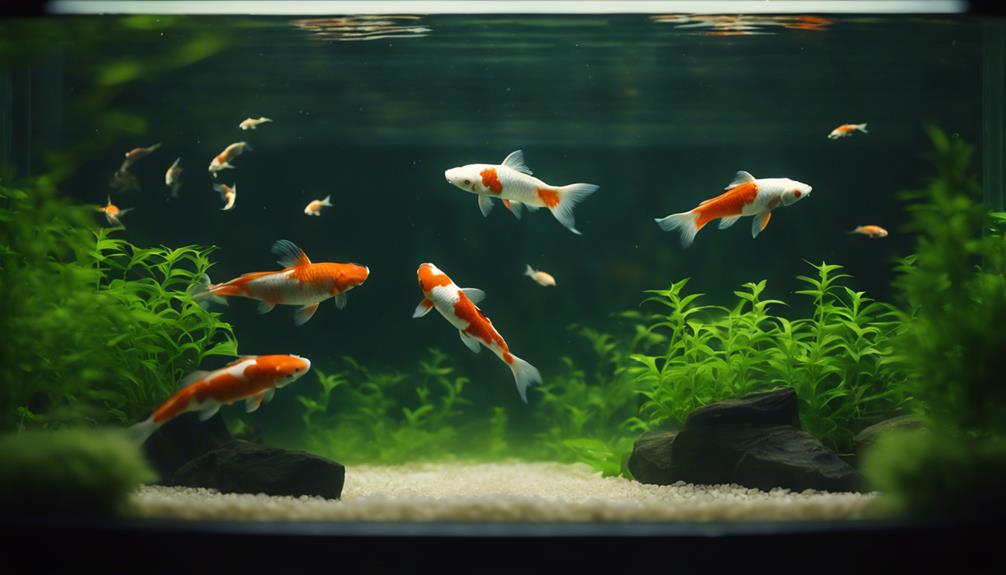
To successfully breed koi, establishing a controlled environment that mirrors their natural habitat is vital, and it's necessary to create a dedicated space that meets the fish's specific requirements.
You'll want to replicate the conditions found in their natural habitats, including water quality, temperature, and lighting.
A reliable filtration system is essential for maintaining clean, oxygen-rich water. Regular water changes and monitoring of ammonia and nitrite levels will guarantee a healthy environment.
Koi thrive in temperatures between 65°F and 85°F (18°C and 30°C). You'll need a reliable heating and cooling system to maintain a stable temperature.
Provide a photoperiod of 10-12 hours of light and 12-14 hours of darkness to simulate a natural day-night cycle.
Guarantee your breeding tank is large enough to accommodate your koi comfortably, with plenty of hiding places and visual barriers to reduce stress.
Breeding and Mating Koi Fish Successfully
When you're breeding koi fish, you'll need to weigh genetic predisposition factors that can affect the success of your breeding program.
You'll also want to optimize mating conditions to increase the chances of successful spawning.
Genetic Predisposition Factors
By understanding the genetic predisposition factors that influence their development, you can substantially improve the chances of successfully breeding and mating koi fish with desirable traits.
Genetic predisposition plays a vital role in determining a koi fish's growth rate, color, pattern, and overall health. As a breeder, selecting koi with desirable genetic traits can increase the chances of producing high-quality offspring with similar characteristics.
The genetic makeup of a koi fish determines its phenotype, or physical characteristics. Breeding koi with a diverse genotype can lead to a more diverse and resilient population.
Understanding the genetic makeup of koi fish can help identify potential genetic defects or weaknesses, allowing you to make informed decisions about breeding pairs and minimize the risk of passing on undesirable traits.
Genetic factors, such as the expression of certain genes, can influence a koi fish's ability to adapt to its environment, making it more or less susceptible to disease and other health issues.
Selecting koi with desirable traits, such as vibrant coloration and strong fins, can increase the chances of producing offspring with similar characteristics.
Optimal Mating Conditions
As you've carefully selected koi with desirable genetic traits, you're now ready to create ideal mating conditions that will increase the chances of successful breeding and mating.
To achieve this, you'll need to provide a controlled environment that simulates the natural spawning process. Begin by segregating males and females in separate tanks for 2-4 weeks prior to breeding. This will allow them to reach peak reproductive readiness.
Next, prepare a spawning tank with a bare bottom, adequate water volume, and a suitable water quality management system. Maintain a water temperature between 64°F and 75°F (18°C and 24°C), as this range promotes successful spawning.
When introducing the select koi to the spawning tank, guarantee a 1:1 or 2:1 male-to-female ratio to prevent over-mating. Finally, provide a stimulus, such as a sudden temperature change or aeration increase, to induce spawning.
Selecting Koi for Breeding Stock
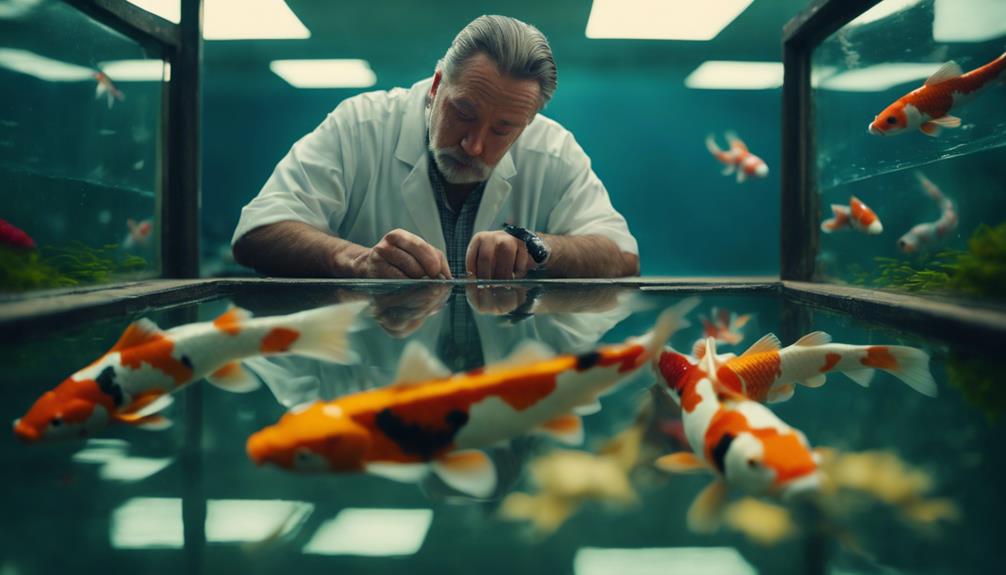
You'll need to carefully evaluate potential breeding stock to identify koi that exhibit the desirable traits necessary for producing high-quality offspring. When selecting koi for breeding, you're not just looking for any fish – you're looking for individuals that will pass on their exceptional characteristics to their offspring.
Age and size: Koi should be at least three to four years old and 12 inches long to guarantee they're mature enough for breeding.
Physical features: Look for female koi with a plump, rounded belly, clear eyes, and shiny scales, indicating good health and fertility.
Coloration and pattern: Choose koi with vibrant, even coloration and a well-defined pattern to increase the chances of producing offspring with similar traits.
Compatibility: Research different koi types and their breeding requirements to verify you're pairing compatible fish that will produce healthy, high-quality offspring.
Caring for Koi Fry and Eggs
Once you've successfully spawned your koi, it's imperative to provide ideal conditions for the eggs and fry to develop, as the first few weeks are critical in determining their survival rates and long-term health.
You'll need to maintain a clean and stable environment, with water temperatures between 65-75°F (18-24°C) and pH levels between 6.5-8.5. Guarantee proper water circulation and oxygenation, as koi fry are sensitive to water quality.
After the female lays her eggs, you'll need to separate them from the adult koi to prevent predation.
Transfer the eggs to a separate breeding tank or a mesh enclosure, and maintain a gentle water flow to prevent the eggs from sticking together. Monitor water quality closely, performing regular water changes and maintaining peak levels of dissolved oxygen.
As the koi fry hatch and grow, continue to provide a nutrient-rich diet, such as brine shrimp or commercial fry food.
Be vigilant for signs of disease or stress, and take prompt action to address any issues.
Frequently Asked Questions
What Is the Importance of Genetics in Fish Breeding?
You understand that genetics play a pivotal role in fish breeding, as they determine fish traits and characteristics, and maintaining genetic diversity is essential to guarantee the long-term health and success of your breeding program.
How Do You Breed a Koi Successfully?
You'll successfully breed koi by setting up dedicated breeding tanks with ideal water quality, selecting mature fish with desirable traits, and creating a stress-free environment that fosters healthy spawning and fry development.
What Should You Do Firstly Before Attempting to Breed Koi?
Before diving into koi breeding, you're like a master chef gathering ingredients – you must research and study the lineage and heritage of your fish to guarantee a recipe for success, understanding their unique characteristics and breeding requirements.
How Old Are Koi When They Start Breeding?
You'll find that koi typically reach mating readiness between 2-5 years, with males achieving breeding age faster than females, and ideal breeding age peaking between 3-10 years old, depending on factors like diet and genetics.
Conclusion
As you set out on your koi fish breeding journey, remember that genetics is the foundation of success.
By understanding the intricacies of chromosomes, meiosis, and sex-determination systems, you'll be better equipped to select ideal breeding stock and create a conducive environment for successful mating.
Did you know that a single koi fish can lay up to 100,000 eggs at a time?
By mastering the genetic aspects of koi breeding, you can increase the chances of producing high-quality offspring and revealing the full potential of your fish.

